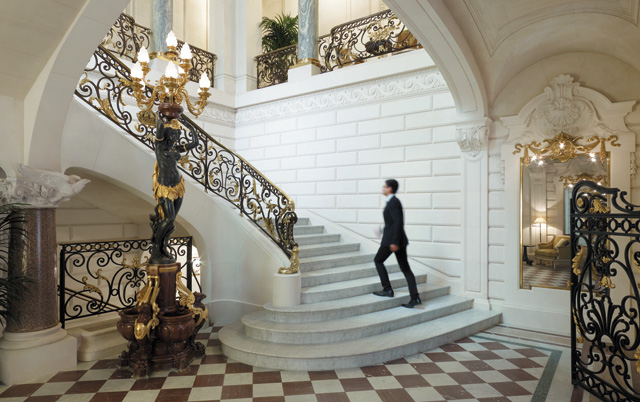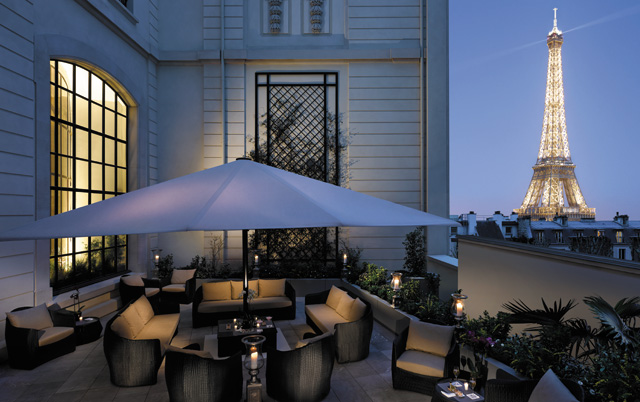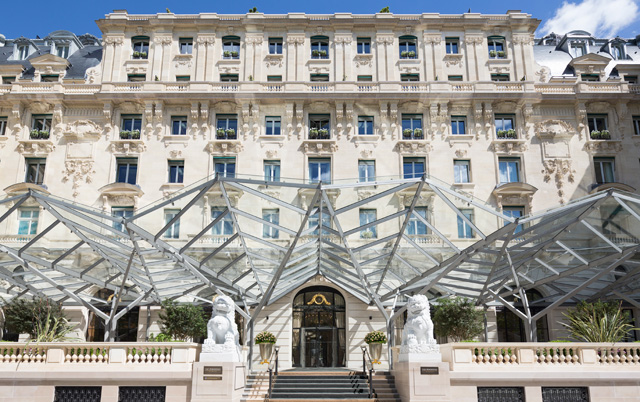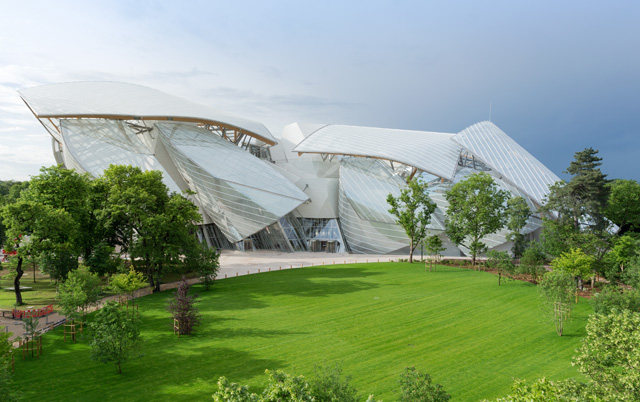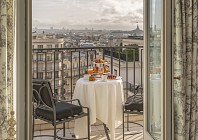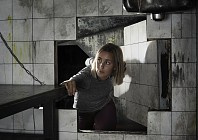At this time of year, golden brown leaves fall from the trees that line the northern bank of the Seine and the air is filled with the woody scent of autumnal decay. As summer gives way to winter, shorter evenings turn into chilly nights, but Parisians cling on to the fading season, filling the bistros and cafés of countless boulevards and cobbled streets with chatter long into the night. This is the Paris of literature and myth, where couples stroll down narrow alleys and waiters pull corks from midday to midnight. The end of summer means nothing here — Paris is eternal, indefatigable and enduring.
This year marks the 70th anniversary of the Liberation of Paris, when American troops and the French Résistance reclaimed the city to joyous scenes, marking the beginning of a party that lasted for days: a celebration of liberty, fortitude and new beginnings. Seventy years later, the joie de vivre is still palpable in Paris, as the city celebrates many more new beginnings.
City on show
The designers whose wares were flaunted at the launch of the Spring-Summer 2015 ready-to-wear collections in Paris last month owe a huge debt to France’s legendary couturiers; the men and women who forged France’s reputation as the home of haute couture. These legendary couturiers are celebrated at Palais Galliera: Musée de la Mode de la Ville de Paris (Paris Fashion Museum), a beautiful 1894 Beaux Arts building where rotating exhibitions examine the history of French high fashion and showcase the masterful work of its top protagonists.

This summer saw the launch of one of the most important exhibitions since the museum reopened in September 2013 after a three-year renovation. Les Années 50 — La Mode en France 1947-1957 celebrates the monumental shifts in fashion design in the post-war era. Less than two years after the end of World War II, when much of France was still repairing the physical and mental scars of two years of German occupation, a little-known couturier launched a new collection in an Avenue Montaigne boutique that would change the world of fashion forever. Just four years later, Christian Dior was responsible for almost 50 percent of the French fashion export industry.
His designs marked the end of post-war frugality, revealing full-length skirts and generous blouses, all of which required decadent amounts of fabric that only the most affluent ladies could afford. As well as the luxuriant use of fabric, the new style gave birth to an era where the feminine form was celebrated, with clinched waistlines and narrow shoulders above exaggerated basque skirts that created an hourglass effect. Harpers Bazaar editor-in-chief Carmel Snow coined the style the ‘New Look’ and designers across Paris began to emulate the designs.
The exhibition celebrates this vibrant era with almost 100 original vintage outfits on display, covering everything from evening gowns to swimwear and accessories; a veritable treasure trove for acolytes of the big ’50s designers like Dior, Chanel, Balenciaga, Pierre Cardin and Givenchy. There are vintage editions of Elle and Paris Match magazines, and some original sketches from the designers’ notepads, all set within the magnificent backdrop of the Palais, with its original mosaic floors and towering domed ceilings. The exhibition runs until November 2 and will be succeeded by another retrospective starting December 9.
Room with a view
Not far from the museum, on a leafy avenue next to the Trocadéro Gardens, lies another must on any Parisian itinerary. Shangri-La Hotel, Paris has one of the finest views in the city from its Garden Wing suites, which opened just over a year ago ¬ a champagne cork’s toss from the Eiffel Tower. Throw open the windows and you’re confronted with a spectacular view of the Paris treasure/monstrosity, depending of which school of thought you subscribe to.
Originally called Palais d’Iéna, the property was commissioned in 1896 by Prince Roland Bonaparte (grand-nephew of Emperor Napoleon Bonaparte), who despised the Eiffel Tower, instructing that his private quarters be built on the opposite side of the building facing away from the monolith. Today, those quarters are the 275-square-metre Suite Impériale, which is fitted out with period furnishings and double-height ceilings. Those who appreciate a good view will no doubt prefer La Suite Shangri-La, whose 100-square-metre outdoor terrace boasts astounding views of Paris. Both command rates of more than EUR 20,000 (US $25,650) per night.
The hotel is steeped in history: several parts including Bonaparte’s family dining room, the reception rooms, the wrought-iron gates, the façade of the building and La Suite Impériale are listed by France’s Monuments Historiques (Historic Monuments) commission, and the entire building was carefully and painstakingly restored over four years by master craftsmen before reopening in 2010. Interior designer Pierre-Yves Rochon was charged with fitting out the interiors, which favour classical style over modern design.

The results are magnifique. Check-in takes place in the wonderful lobby library, to the right of the entrance — a series of small reception rooms with a fireplace and period furnishings that were formerly used to entertain guests. The main staircase marks the beginning of the second wing of the building, which once housed the Prince’s private quarters and libraries; now the ballroom and function rooms. Everywhere you turn, you see marble pillars and polished mosaic floors; stucco ceilings and restored statues. It’s like walking into a private museum. The former stables of the palace have been converted into a bright wellness area complete with 15-metre pool, which is a welcome escape from the bustle of Paris beyond the hotel walls, in the heart of one of the city’s most charming neighbourhoods.
Some of the brand’s Asian heritage shines through at Shang Palace, Shangri-La’s signature restaurant, which was awarded its first Michelin star in 2012. It’s the only part of the hotel that doesn’t embody the classical French style, but a long lunch of traditional Cantonese cuisine courtesy of chef Frank Xu will transport you across the globe to a world of Asian refinement and flavour.
Those who want to continue their Bonaparte history lesson can take a short post-meal limousine ride across the Seine to the Hôtel National des Invalides, where the tomb of Napoleon resides alongside some of his lesser-known relatives and other French military heroes.
Cuisine du jour
Paris’ story isn’t just told in its historic buildings. The city’s food scene is perpetually redefining itself so carefully so as not to lose that unmistakable French character. Head to Avenue Kléber, just off the Arc de Triomphe, where the brand-new Peninsula Paris has already made an impression among diplomats, VIPs and Peninsula fans eager to experience the Asian hotel company’s first European hotel. I walk straight past the wonderful Lasvit-designed Dancing Leaves sculpture in the main lobby, skip the historical Bar Kléber, where Henry Kissinger signed the Vietnam peace accord in 1973, and head straight for the top-floor restaurant, L’Oiseau Blanc.
Named after the first aircraft to attempt to fly across the Atlantic, which disappeared shortly after taking off from Paris on May 8, 1927, never to be seen again, L’Oiseau Blanc is The Peninsula’s signature French gastronomy restaurant. A 3:4 scale model of the aircraft hangs suspended above the intricate central courtyard of the hotel. The main dining room of L’Oiseau Blanc is surrounded by sloping, wraparound glass windows on three sides, like the cockpit of an aircraft, with impressive views over the city. There’s a reproduction of the ill-fated aircraft’s engine and vintage
airport runway spotlights decorating the room, complementing the masculine tones of black, brown and navy blue leather, which are all offset by light wood floors, white tablecloths and white crockery with little aircraft motifs.
The food is classically French, with beautifully presented dishes. I sample the starter of Isigny salmon, marinated with pink berries and mild mustard, rhubarb relish, radish and celery —
a veritable work of art on the plate and the palate. This is followed by a wonderful, pungent Lozère lamb flavoured with garlic from Lautrec, yet more black garlic and rocket salad. Tables on the wonderful outside terrace, with views spanning the Sacré-Coeur, Notre Dame and the ubiquitous Eiffel Tower, are booked up until November, and on a clear, late summer day, I can see why.
Art Nouveau
Paris never rests on its laurels and this month sees the opening of two more landmarks that will peak the interest of the discerning arts enthusiast. The Musée Picasso Paris reopens on October 25 in the 17th-century Hôtel de Salé in the heart of the colourful Marais district, after a major renovation. As well as the permanent collection, which includes more than 5,000 original Picasso works spanning the Spanish artist’s entire career, the opening will kick off with an exhibition dedicated to the history of the Hôtel de Salé from 1656 until today. The presence of the museum in the neighbourhood since the 1970s has contributed to the Marais’ emergence as a major centre for the arts. Small contemporary gallery spaces are clustered around the bustling Place des Vosges, and countless tiny side streets that invite a leisurely stroll.
The Fondation Louis Vuitton is the other major development opening in Paris this month; a hulking, Frank Gehry-designed building in the Jardin d’Acclimatation that will house a space dedicated to contemporary art, with permanent and temporary exhibitions in 11 galleries, live performances in a 350-seat auditorium, and an artist-in-residence programme. It opens on October 27 with an exhibition showcasing the design and construction of the glass and metal building, to coincide with a Frank Gehry retrospective, which kicks off at the Centre Pompidou on October 8.
Humphrey Bogart spoke for all mankind when he told Ingrid Bergman, “We’ll always have Paris,” in the film Casablanca. Anyone who has visited the French capital will no doubt have dear memories of their time there, whether it is a romantic moment on the Seine, a successful meeting at a 1st arrondissement ‘Palace’ hotel, or an unforgettable meal in one of the city’s innumerable restaurants. As the city continues to grow, refresh and revitalise itself, every visit brings new experiences, keeping Paris close our hearts and providing a benchmark for what a true luxury travel experience should be.
THE GOLDEN BOOK
Shangri-La Hotel, Paris
Tel: +33 1 5367 1998
www.shangri-la.com
Mandarin Oriental Paris
Tel: +33 1 7098 7888
www.mandarinoriental.com
The Peninsula Paris
Tel: +33 1 5812 2888
paris.peninsula.com
Visit Paris Region
www.visitparisregion.com

